+ Open data
Open data
- Basic information
Basic information
| Entry | Database: PDB / ID: 6vyg | ||||||||||||||||||||||||
|---|---|---|---|---|---|---|---|---|---|---|---|---|---|---|---|---|---|---|---|---|---|---|---|---|---|
| Title | Cryo-EM structure of Plasmodium vivax hexokinase (Closed state) | ||||||||||||||||||||||||
 Components Components | Phosphotransferase | ||||||||||||||||||||||||
 Keywords Keywords | TRANSFERASE / Hexokinase | ||||||||||||||||||||||||
| Function / homology |  Function and homology information Function and homology informationTransferases; Transferring phosphorus-containing groups; Phosphotransferases with an alcohol group as acceptor / fructokinase activity / glucokinase activity / D-glucose binding / intracellular glucose homeostasis / glycolytic process / glucose metabolic process / mitochondrion / ATP binding / cytosol Similarity search - Function | ||||||||||||||||||||||||
| Biological species |  | ||||||||||||||||||||||||
| Method | ELECTRON MICROSCOPY / single particle reconstruction / cryo EM / Resolution: 3.5 Å | ||||||||||||||||||||||||
 Authors Authors | Srivastava, S.S. / Darling, J.E. / Suryadi, J. / Morris, J.C. / Drew, M.E. / Subramaniam, S. | ||||||||||||||||||||||||
| Funding support |  Canada, 1items Canada, 1items
| ||||||||||||||||||||||||
 Citation Citation |  Journal: IUCrJ / Year: 2020 Journal: IUCrJ / Year: 2020Title: and human hexokinases share similar active sites but display distinct quaternary architectures. Authors: Shanti Swaroop Srivastava / Joseph E Darling / Jimmy Suryadi / James C Morris / Mark E Drew / Sriram Subramaniam /   Abstract: Malaria is a devastating disease caused by a protozoan parasite. It affects over 300 million individuals and results in over 400 000 deaths annually, most of whom are young children under the age ...Malaria is a devastating disease caused by a protozoan parasite. It affects over 300 million individuals and results in over 400 000 deaths annually, most of whom are young children under the age of five. Hexokinase, the first enzyme in glucose metabolism, plays an important role in the infection process and represents a promising target for therapeutic intervention. Here, cryo-EM structures of two conformational states of hexokinase (PvHK) are reported at resolutions of ∼3 Å. It is shown that unlike other known hexokinase structures, PvHK displays a unique tetrameric organization (∼220 kDa) that can exist in either open or closed quaternary conformational states. Despite the resemblance of the active site of PvHK to its mammalian counterparts, this tetrameric organization is distinct from that of human hexokinases, providing a foundation for the structure-guided design of parasite-selective antimalarial drugs. | ||||||||||||||||||||||||
| History |
|
- Structure visualization
Structure visualization
| Movie |
 Movie viewer Movie viewer |
|---|---|
| Structure viewer | Molecule:  Molmil Molmil Jmol/JSmol Jmol/JSmol |
- Downloads & links
Downloads & links
- Download
Download
| PDBx/mmCIF format |  6vyg.cif.gz 6vyg.cif.gz | 304.1 KB | Display |  PDBx/mmCIF format PDBx/mmCIF format |
|---|---|---|---|---|
| PDB format |  pdb6vyg.ent.gz pdb6vyg.ent.gz | 246.3 KB | Display |  PDB format PDB format |
| PDBx/mmJSON format |  6vyg.json.gz 6vyg.json.gz | Tree view |  PDBx/mmJSON format PDBx/mmJSON format | |
| Others |  Other downloads Other downloads |
-Validation report
| Summary document |  6vyg_validation.pdf.gz 6vyg_validation.pdf.gz | 961.4 KB | Display |  wwPDB validaton report wwPDB validaton report |
|---|---|---|---|---|
| Full document |  6vyg_full_validation.pdf.gz 6vyg_full_validation.pdf.gz | 977.7 KB | Display | |
| Data in XML |  6vyg_validation.xml.gz 6vyg_validation.xml.gz | 48 KB | Display | |
| Data in CIF |  6vyg_validation.cif.gz 6vyg_validation.cif.gz | 73.8 KB | Display | |
| Arichive directory |  https://data.pdbj.org/pub/pdb/validation_reports/vy/6vyg https://data.pdbj.org/pub/pdb/validation_reports/vy/6vyg ftp://data.pdbj.org/pub/pdb/validation_reports/vy/6vyg ftp://data.pdbj.org/pub/pdb/validation_reports/vy/6vyg | HTTPS FTP |
-Related structure data
| Related structure data |  21459MC  6vyfC M: map data used to model this data C: citing same article ( |
|---|---|
| Similar structure data |
- Links
Links
- Assembly
Assembly
| Deposited unit | 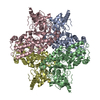
|
|---|---|
| 1 |
|
- Components
Components
| #1: Protein | Mass: 56851.543 Da / Num. of mol.: 4 Source method: isolated from a genetically manipulated source Source: (gene. exp.)  Gene: PVC01_110030900, PVP01_1125500, PVT01_110029900 / Production host:  References: UniProt: A0A1G4HFC9, UniProt: A5K274*PLUS, Transferases; Transferring phosphorus-containing groups; Phosphotransferases with an alcohol group as acceptor Has protein modification | Y | |
|---|
-Experimental details
-Experiment
| Experiment | Method: ELECTRON MICROSCOPY |
|---|---|
| EM experiment | Aggregation state: PARTICLE / 3D reconstruction method: single particle reconstruction |
- Sample preparation
Sample preparation
| Component | Name: Plasmodium vivax hexokinase / Type: COMPLEX / Entity ID: all / Source: RECOMBINANT |
|---|---|
| Source (natural) | Organism:  |
| Source (recombinant) | Organism:  |
| Buffer solution | pH: 7.5 / Details: 20 mM Tris, pH 7.5, 50 mM NaCl, 1 mM TCEP |
| Specimen | Embedding applied: NO / Shadowing applied: NO / Staining applied: NO / Vitrification applied: YES |
| Specimen support | Grid material: COPPER / Grid mesh size: 200 divisions/in. / Grid type: Quantifoil R1.2/1.3 |
| Vitrification | Instrument: FEI VITROBOT MARK IV / Cryogen name: ETHANE / Humidity: 100 % / Chamber temperature: 293 K |
- Electron microscopy imaging
Electron microscopy imaging
| Experimental equipment |  Model: Titan Krios / Image courtesy: FEI Company |
|---|---|
| Microscopy | Model: FEI TITAN KRIOS |
| Electron gun | Electron source:  FIELD EMISSION GUN / Accelerating voltage: 300 kV / Illumination mode: FLOOD BEAM FIELD EMISSION GUN / Accelerating voltage: 300 kV / Illumination mode: FLOOD BEAM |
| Electron lens | Mode: BRIGHT FIELD |
| Image recording | Electron dose: 60.32 e/Å2 / Detector mode: SUPER-RESOLUTION / Film or detector model: GATAN K2 SUMMIT (4k x 4k) |
- Processing
Processing
| Software | Name: PHENIX / Version: 1.16_3549: / Classification: refinement | ||||||||||||||||||||||||
|---|---|---|---|---|---|---|---|---|---|---|---|---|---|---|---|---|---|---|---|---|---|---|---|---|---|
| EM software |
| ||||||||||||||||||||||||
| CTF correction | Type: PHASE FLIPPING AND AMPLITUDE CORRECTION | ||||||||||||||||||||||||
| Particle selection | Num. of particles selected: 181611 | ||||||||||||||||||||||||
| Symmetry | Point symmetry: D2 (2x2 fold dihedral) | ||||||||||||||||||||||||
| 3D reconstruction | Resolution: 3.5 Å / Resolution method: FSC 0.143 CUT-OFF / Num. of particles: 6623 / Algorithm: FOURIER SPACE / Num. of class averages: 1 / Symmetry type: POINT | ||||||||||||||||||||||||
| Refine LS restraints |
|
 Movie
Movie Controller
Controller





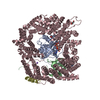
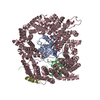
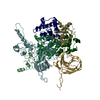
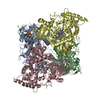
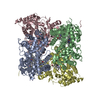


 PDBj
PDBj
